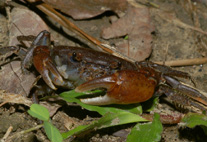Abstract
Khodutka geothermal area is located near Khodutka and Priemysh volcanoes and is one of the largest geothermal areas of the Kamchatka Peninsula. Vakin (2003) described geological, geochemical and geothermic conditions of this geothermal area in detail. The main thermal water sources have temperatures up to 87°C and a discharge of approximately 150 l×sec.-1 are flows out into the warm lake with dimensions of ca. 250 m length and 80 m width. This warm river is ca. 20 m in width beginning from the lake and flows to the Bolshaya Khodutka River basin. Two local endemic Radix species were described from this geothermal area, especially Lymnaea (Radix) hadutkae Kruglov & Starobogatov, 1989 and L. (R.) thermokamtschatica Kruglov & Starobogatov, 1989 (Kruglov & Starobogatov 1989, 1993; Kruglov 2005). These species were separated using proportions of shell and reproductive system (Kruglov & Starobogatov 1989, 1993; Starobogatov et al. 2004). According to the diagnosis, L. (R.) hadutkae differs in the ear-shape shell, a form of the provaginal duct with cylindrical distal part and conical proximal part, and larger value of the index of the copulatory apparatus (ICA: proportion of the preputium to phallotheca is 1.27) from other species within the section Thermoradix Kruglov & Starobogatov, 1989. The last whorl is large, 0.86–0.89 of the shell height; an excess of the last whorl over upper margin of the aperture is 0.15–0.16 of the aperture height. L. (R.) thermokamtschatica has the cylindrical provaginal duct, relatively short bursa duct (1.5X longer than the bursa copulatrix diameter) and very long phallotheca (ICA is 0.77). The last whorl is large, 0.85–0.87 of the shell height; an excess of the last whorl over upper margin of the aperture is 0.2–0.25 of the aperture height. In accordance with an identification key (Starobogatov et al. 2004), the main diagnostic feature is an excess of the last whorl over the shell aperture, which has ≤0.78 and ≥0.80 of the penultimate whorl width in the first and second species, respectively. In the present paper, we revised these taxa using newly collected topotypes and additional Radix spp. specimens from other areas of the Russian Far East.

